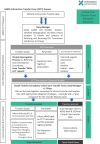Lessons learned from the first 50 COVID-19 critical care transfer missions conducted by a civilian UK Helicopter Emergency Medical Service team
- PMID: 35033171
- PMCID: PMC8760584
- DOI: 10.1186/s13049-022-00994-7
Lessons learned from the first 50 COVID-19 critical care transfer missions conducted by a civilian UK Helicopter Emergency Medical Service team
Abstract
Background: The COVID-19 pandemic has placed exceptional demand on Intensive Care Units, necessitating the critical care transfer of patients on a regional and national scale. Performing these transfers required specialist expertise and involved moving patients over significant distances. Air Ambulance Kent Surrey Sussex created a designated critical care transfer team and was one of the first civilian air ambulances in the United Kingdom to move ventilated COVID-19 patients by air. We describe the practical set up of such a service and the key lessons learned from the first 50 transfers.
Methods: Retrospective review of air critical care transfer service set up and case review of first 50 transfers.
Results: We describe key elements of the critical care transfer service, including coordination and activation; case interrogation; workforce; training; equipment; aircraft modifications; human factors and clinical governance. A total of 50 missions are described between 18 December 2020 and 1 February 2021. 94% of the transfer missions were conducted by road. The mean age of these patients was 58 years (29-83). 30 (60%) were male and 20 (40%) were female. The mean total mission cycle (time of referral until the time team declared free at receiving hospital) was 264 min (range 149-440 min). The mean time spent at the referring hospital prior to leaving for the receiving unit was 72 min (31-158). The mean transfer transit time between referring and receiving units was 72 min (9-182).
Conclusion: Critically ill COVID-19 patients have highly complex medical needs during transport. Critical care transfer of COVID-19-positive patients by civilian HEMS services, including air transfer, can be achieved safely with specific planning, protocols and precautions. Regional planning of COVID-19 critical care transfers is required to optimise the time available of critical care transfer teams.
Keywords: COVID-19; Critical care; Helicopter Emergency Medical Services; Intensive care; Transfer medicine.
© 2022. The Author(s).
Conflict of interest statement
This study met criteria for service evaluation, as defined by the UK National Institute of Healthcare Research. Formal ethical approval was therefore not required. All data was sourced from the internal AAKSS database. No competing interests were declared. No funding was received for this study. All authors contributed to data review and manuscript writing.
None to declare.
Figures
References
-
- Pett E, Leung HL, Taylor E, Chong MSF, Hla TTW, Sartori G, Sathianathan V, Husain T, Suntharalingam G, Rosenberg A, Walsh A, Wigmore T. Critical care transfers and COVID-19: managing capacity challenges through critical care networks. 2020. 2020100125. 10.20944/preprints202010.0125.v1. - PMC - PubMed
-
- Intensive Care Society. Clinical Guidance: Assessing whether COVID-19 patients will benefit from critical care, and an objective approach to capacity challenges. 2020. www.wcctn.wales.nhs.uk/sitesplus/documents/1210/COVID%5F19%5Fcare%5Fguid.... Accessed 13 July 2020. - PMC - PubMed
MeSH terms
LinkOut - more resources
Full Text Sources
Medical




